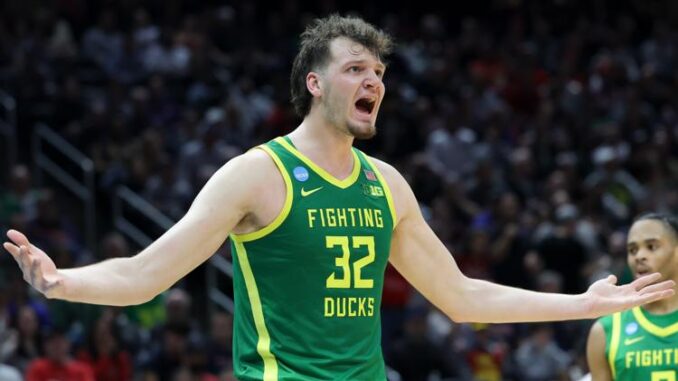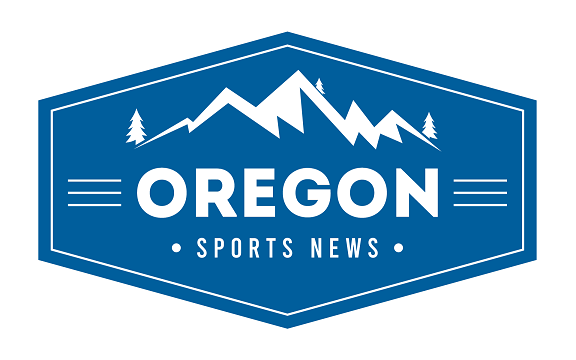
In the star-fogged world of college basketball, the path from McDonald’s All-American to NBA hopeful is usually quite straightforward. However, for Nate Bittle, it’s starting to look a little more like a detour. The 7-foot Duck center arrived in Eugene as a 5-star recruit, with high expectations and potential. But as his college journey began to unfold, the surrounding narrative slowly began to shift.
As the NBA Draft Combine invites began to roll out, one name was conspicuously absent: Nate Bittle. It was not just a quiet omission but a subtle but telling checkpoint in a career that once seemed destined for the spotlight. So, how exactly did a once top prospect in the country slip out of the early NBA draft discussions?
Hype to Hush
In retrospect, Bittle was a wiry but highly skilled big man in his high school days. Despite having a rather skinny body frame, Bittle was still hailed as one of the top recruits in his class. As a matter of fact, ESPN ranked him as the number 8 overall prospect and second-best center in its Top 100 list. Prior to joining the Ducks, Bittle’s game tape told of a modern center; rangy, mobile, with a soft shooting touch and a willingness to protect the rim at all times.
The 7-footer was projected to be the heir to Oregon’s defensive identity—a defensive-minded center who could swat shots and stretch the floor. Bittle would end up settling for the Ducks over UCLA and Gonzaga. From the onset, it was quite clear that Oregon had landed a gem.
However, 3 seasons down the line, the buzz has significantly faded. Despite the flashes and brief moments of genuine two-way dominance, Bittle has struggled to string together a complete narrative. The game logs are speckled with promise: a 21-point here and a 5-block game there.
But that’s just about it. A bigger portion of the game logs are punctuated by silence; single-digit scoring nights, missed games because of injuries, or just long stretches of limited impact. When the NBA announced its 78 invites this spring, Bittle’s name was notoriously absent.
To make matters worse, Bittle’s name was also equally absent among the G League Elite Camp alternates. This omission was not just puzzling but loud for a player who was once considered to be among the crème de la crème of his recruiting class.
What the NBA Combine Omission Really Says
Although the NBA combine does not always paint a clear picture of the basketball landscape, it does serve as a good indicator of who is currently on the league’s radar. An invitation to the combine often means that the front offices have seen enough potential in a player to warrant closer evaluation. This can be attained through measurements, interviews, and live scrimmages.
That being said, the NBA Combine invite does not guarantee that a player will be drafted. However, it usually is a good signal that the player is part of a broader conversation. Bittle is not receiving the invite, which does raise questions.
Could it be that the NBA scouts are still trying to figure out what type of player he projects to be at the next level? Is Bittle a stretch five, a traditional big, or someone who is more of a rim protector? For any team, Bittle brings size, timing, and a menacing defensive presence. However, consistent production, sustained health, and a clearly defined role have been harder to pin down. These are the key areas that are crucial when teams are evaluating long-term potential.
That being said, this does not necessarily reflect a hard verdict on Bittle, but it’s more likely a signal that teams are still going on with the evaluation process.
Long-Game is Not Over
Bittle’s journey is far from over. At just 21 years, he still has time to grow physically and his game as well. While missing this year’s combine may be a setback to the youngster, it doesn’t close any doors. If anything, it presents a chance to regroup and refocus.
The young star has already familiarized himself with Dana Altman’s system and has defensive instincts that show real promise. If Oregon can manage to stay healthy and adapt to the Big 10, then the opportunity will be there for Bittle to lead the Ducks to a much better finish in next year’s NCAA tourney.
In addition to this, the current college landscape with transfer flexibility and NIL landscape offers players more leverage than ever. Bittle does not need to rush into a pro-opportunity that does not guarantee stability or simply is not the right fit. By returning and producing consistently, something like 20+ points per game and 8 rebounds with solid shooting, then Bittle could earn a second look from the scouts. This would not be unprecedented.
Players like Zack Edey and Trayce Jackson-Davis remained in college, developed their games, and, consequently, improved their draft position significantly. Even former Ducks star Chris Boucher followed a relatively longer path to the league. Growth timeliness varies, and Bittle still has room.
Conclusion
Should Bittle opt to return to the Ducks, the young prodigy could end up positioning himself at the heart and soul of Oregon’s frontcourt again next season. His physicality tools remain appealing: shot-blocking ability, height, soft touch around the rim, and flashes of range.
The young star has been missing sustained impact, including consistent minutes, steady production, and more standout performances that stick out with the scouts. That being said, another year in Eugene and the chance to build continuity could offer Bittle the foundation he is missing.
The young star will have the benefit of a coaching staff that clearly knows how to use him and a platform to make his case. Over the years, the NBA has shown patience for players who take time to fully develop. For Bittle, the next step is about turning potential into reliability and showing that the wait may be worth it.
